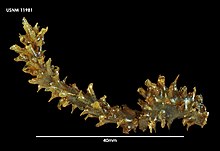Our website is made possible by displaying online advertisements to our visitors.
Please consider supporting us by disabling your ad blocker.
Hemichordate
| Hemichordate Temporal range:
| |
|---|---|

| |
| Acorn worm (Enteropneusta) | |

| |
| Cephalodiscus nigrescens (Pterobranchia) | |
| Scientific classification | |
| Domain: | Eukaryota |
| Kingdom: | Animalia |
| Subkingdom: | Eumetazoa |
| Clade: | ParaHoxozoa |
| Clade: | Bilateria |
| Clade: | Nephrozoa |
| Superphylum: | Deuterostomia |
| Clade: | Ambulacraria |
| Phylum: | Hemichordata Bateson, 1885 |
| Classes | |
Hemichordata (/ˌhɛmɪkɔːrˈdeɪtə/ HEM-ih-kor-DAY-tə) is a phylum which consists of triploblastic, eucoelomate, and bilaterally symmetrical marine deuterostome animals, generally considered the sister group of the echinoderms. They appear in the Lower or Middle Cambrian and include two main classes: Enteropneusta (acorn worms), and Pterobranchia. A third class, Planctosphaeroidea, is known only from the larva of a single species, Planctosphaera pelagica. The class Graptolithina, formerly considered extinct,[1] is now placed within the pterobranchs, represented by a single living genus Rhabdopleura.
Acorn worms are solitary worm-shaped organisms. They generally live in burrows (the earliest secreted tubes)[2] and are deposit feeders, but some species are pharyngeal filter feeders, while the family are free living detritivores. Many are well known for their production and accumulation of various halogenated phenols and pyrroles.[3] Pterobranchs are filter-feeders, mostly colonial, living in a collagenous tubular structure called a coenecium.[4]
The discovery of the stem group hemichordate Gyaltsenglossus shows that early hemichordates combined aspects of the two morphologically disparate classes.[5]
- ^ Sato, Atsuko; Rickards RB; Holland PWH (December 2008). "The origins of graptolites and other pterobranchs: a journey from 'Polyzoa'". Lethaia. 41 (4): 303–316. Bibcode:2008Letha..41..303S. doi:10.1111/j.1502-3931.2008.00123.x.
- ^ Caron, J. B.; Conway Morris, S.; Cameron, C. B. (2013). "Tubicolous enteropneusts from the Cambrian period". Nature. 495 (7442): 503–506. Bibcode:2013Natur.495..503C. doi:10.1038/nature12017. PMID 23485974. S2CID 205233252.
- ^ Giray, Cem; G.M. King (1997). "Predator deterrence and 2,4-dibromophenol conservation by the enteropneusts, Saccoglossus bromophenolosus and Protoglossus graveolens". Marine Ecology Progress Series. 159: 229–238. Bibcode:1997MEPS..159..229G. doi:10.3354/meps159229.
- ^ {{cite definition coenecium (plural coenecia) (biology) A branching tubular network inhabited by colonies of pterobranches journal|last=Sato|first=Atsuko|author2=Bishop JDD |author3=Holland PWH |title=Developmental biology of pterobranch hemichordates: history and perspectives|journal=Genesis|year=2008|volume=46|pages=587–91|doi=10.1002/dvg.20395|pmid=18798243|issue=11|s2cid=37286764 |doi-access=}}
- ^ ROM, Karma (Fall 2020). "A Cambrian Puzzle: An Ancient, Fossilized Marine Worm Crawls into the Light". ROM Magazine. Toronto: Royal Ontario Museum.
Previous Page Next Page


